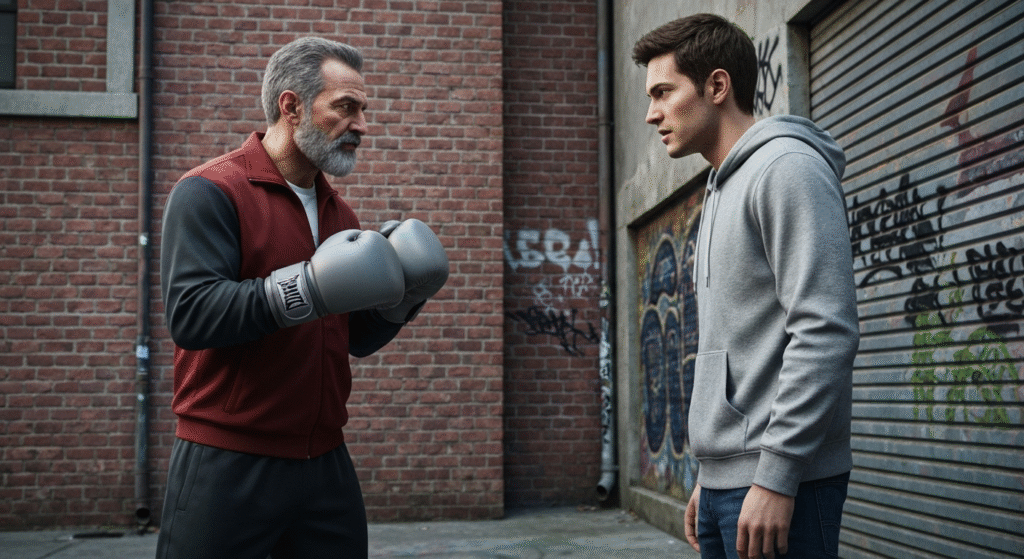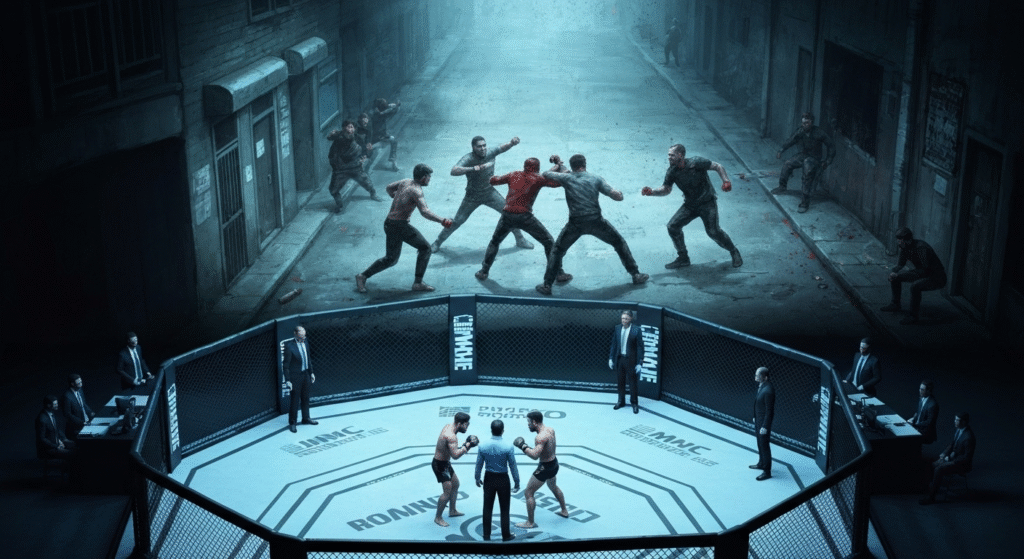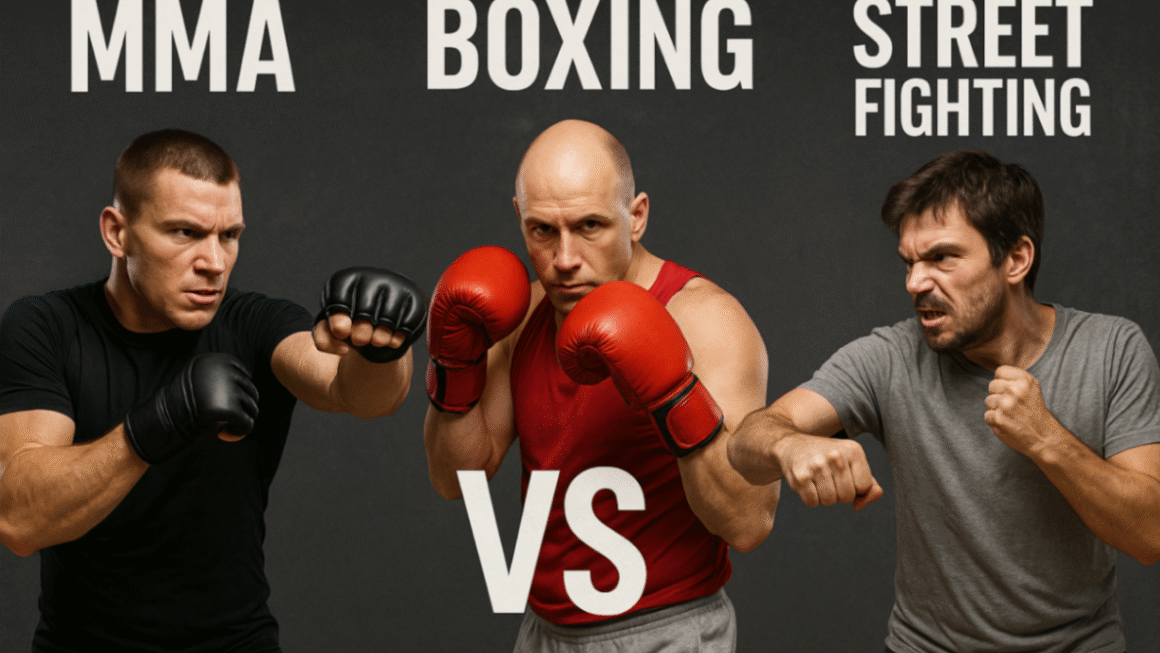Key Highlights
- Street fighting is an unpredictable, illegal confrontation with no rules, referees, or safety measures.
- Mixed Martial Arts (MMA) is a regulated sport, like the UFC, combining various martial arts disciplines with strict rules for fighter safety.
- An MMA fighter’s training covers striking and grappling, providing a significant advantage in a one-on-one confrontation.
- Street fighting often involves dirty tactics like groin strikes and eye-gouging, which are illegal in MMA.
- The fighting style of an MMA fighter is honed in a gym, while a street fighter’s skills are developed through raw, real-world altercations.
Introduction
When you hear the terms street fighting and Mixed Martial Arts (MMA), you might picture similar scenes of intense combat. However, these two forms of fighting are fundamentally different. While MMA fighters possess incredible skills derived from various martial arts, a real street confrontation is a chaotic and lawless event. Understanding the distinctions between a regulated sport and a no-holds-barred brawl is crucial for appreciating the unique dangers and skill sets associated with each.
Defining Street Fighting and MMA

Street fighting is not a formal discipline but an illegal, spontaneous act of violence. It occurs in unpredictable environments and lacks any form of rules, rounds, or officials. The primary goal is simply to survive or incapacitate an opponent by any means necessary.
Conversely, MMA is a legitimate, full-contact combat sport. It involves athletes trained in mixed martial arts who compete under a specific set of regulations. The fighting style combines techniques from various disciplines to create a well-rounded combat system used within a controlled setting.
What Constitutes a Street Fight?
A street fight is the definition of chaos. It is an unsanctioned and often illegal physical altercation that erupts suddenly in a public or private space. Unlike a sporting contest, there are no rules, no weight classes, and no referee to stop the action. The environment itself can become a weapon, with hard pavement, walls, and other objects changing the dynamic of the conflict entirely.
The objective in this scenario is not to score points but to end the threat as quickly as possible. A street fighter may face multiple attackers, hidden weapons, and tactics that are strictly forbidden in any legitimate combat sport. This raw and dangerous reality means survival is the only prize.
Many self-defense systems, such as Krav Maga, are designed specifically to address this brutal context. They focus on neutralizing attackers with extreme prejudice, often utilizing moves like groin strikes and eye pokes that are considered “dirty” in a formal fighting discipline but are vital for self-preservation on the street.
What Is MMA and How Is It Structured?
Mixed Martial Arts, or MMA, is a highly organized and sophisticated combat sport. It allows competitors from different martial arts backgrounds to test their skills against one another in a controlled environment. An MMA fight is governed by a unified set of rules that ensures a fair contest and prioritizes the safety of the athletes.
The structure of MMA includes weight classes, timed rounds, and the presence of a trained referee who can stop the fight if a fighter is unable to defend themselves, commits a foul, or submits. Fights take place in a designated area, like a cage or ring, which prevents outside interference and defines the field of play.
This sport is a true blend of disciplines, requiring fighters to be proficient in both striking and ground fighting. The evolution of MMA has shown that combining techniques from arts like wrestling, Brazilian Jiu-Jitsu (BJJ), and Muay Thai creates the most effective and versatile athletes for this specific type of competition.
Rules and Regulations: Formality vs Chaos

The most significant distinction between MMA and street fighting lies in the presence versus the total absence of rules. In MMA, a comprehensive rulebook exists to protect the fighters and ensure the contest is a test of skill, not brutality. A referee enforces these regulations, stepping in to prevent serious injury.
This formality stands in stark contrast to the pure chaos of a street fight, where no such protections exist. The following sections will explore the specific safety protocols that govern an MMA match and the dangerous, rule-free nature of a real-world altercation.
MMA Rules and Safety Protocols
Safety is a paramount concern in professional MMA. The sport is governed by a detailed set of MMA rules designed to minimize unnecessary harm while still allowing for a decisive outcome. A central figure in ensuring safety is the referee, who has the authority to stop a fight, deduct points for fouls, and ensure that techniques like joint locks and chokes are released once an opponent submits.
Competitions are divided into weight classes to ensure fighters are evenly matched physically. Furthermore, fighters wear protective gear, such as gloves, and are medically cleared before and after each bout. The rules explicitly forbid life-threatening or unsportsmanlike actions.
This structured approach ensures that while the sport is intense, it remains a contest of athletic skill rather than a lawless brawl.
|
Allowed Techniques |
Forbidden Tactics |
|---|---|
|
Punches, kicks, elbows, and knees to the body and head |
Eye-gouging and fish-hooking |
|
Takedowns and throws |
Groin strikes of any kind |
|
Joint locks (e.g., armbars, kimuras) |
Headbutts and biting |
|
Chokes (e.g., rear-naked choke, guillotine) |
Strikes to the back of the head or spine |
Absence of Rules in Street Fighting
In the unpredictable environment of street fighting, there are no rules to follow. The singular goal is to survive and escape the situation, which means any and all tactics are on the table. This “do whatever it takes” mentality is the defining characteristic of a real-world confrontation.
An attacker on the street will not hesitate to use methods that are banned in any combat sport. The danger is amplified because a street fight is not a fair, one-on-one contest. There is a constant threat of hidden weapons, multiple attackers joining the fray, or the fight spilling onto dangerous surfaces like concrete or asphalt.
Common tactics employed by aggressors in a street fight include:
- Groin strikes
- Biting and eye-gouging
- Using improvised weapons (bottles, keys, etc.)
This brutal reality means that self-preservation often requires a completely different mindset than that of a competitive athlete.
Techniques and Skillsets Utilized
The vast difference in rules and environment naturally leads to the use of different techniques and fighting styles. Mixed Martial Arts is built on a foundation of proven martial arts like Muay Thai, boxing, and wrestling, refined for sport competition. The goal is to blend these disciplines into a seamless and effective fighting style.
In contrast, street fighting techniques are based on brutal efficiency and survival. Philosophies like Bruce Lee’s Jeet Kune Do, which emphasizes intercepting an opponent’s attack with maximum simplicity and directness, are more aligned with the needs of a real-world fight than a structured kickboxing match.
Striking and Grappling in MMA
The technical arsenal of an MMA fighter is divided into two primary domains: striking and grappling. This dual proficiency is what makes the sport so dynamic. An MMA fight can be won either on the feet with powerful strikes or on the ground with dominant grappling control.
Striking in MMA incorporates techniques from boxing, kickboxing, and Muay Thai, teaching fighters how to attack effectively from various ranges. Grappling, on the other hand, is a blend of wrestling and Brazilian Jiu-Jitsu (BJJ). This allows a fighter to control an opponent in the clinch, take them to the ground, and secure a submission.
The core components of an MMA skillset include:
- Stand-up: Punches, kicks, elbows, and knees.
- Clinch work: Controlling an opponent against the cage or in open space.
- Ground Game: Takedowns, positional control, and submissions like chokes and joint locks.
Common Tactics in Street Fighting
Tactics in street fighting are not about technique or form; they are about causing immediate damage to neutralize a threat. A street fighter will exploit any opening and use any means necessary to win. This often involves targeting an opponent’s most vulnerable areas to cause pain and create an opportunity for escape.
Unlike in MMA, where ground fighting is a complex art, going to the ground in a street fight can be incredibly dangerous. Hard surfaces can cause serious injury, and being on the ground makes you vulnerable to being stomped or kicked, especially if there are multiple attackers. Martial arts like Krav Maga teach practitioners to avoid the ground or get back to their feet as quickly as possible.
Common street fighting tactics focus on raw effectiveness:
- Surprise Attacks: A sudden, overwhelming assault to stun the opponent.
- Targeting Vulnerable Points: Strikes to the eyes, throat, and groin.
- Using the Environment: Shoving an opponent into a wall or using nearby objects as weapons.
Training Approaches: Gym vs Real-World Experience
The path to becoming proficient in MMA versus becoming a seasoned street fighter could not be more different. MMA training is a disciplined, scientific process conducted in a specialized gym, where MMA fighters systematically build their skills under the guidance of expert coaches.
A street fighter, however, learns through the harsh lessons of real-world conflict. Their training ground is the unpredictable environment of an actual fight, and their skills are forged by necessity and survival instinct rather than structured practice. The following sections will compare these two divergent paths.
How MMA Fighters Train for Competition
The training regimen of MMA fighters is intense, structured, and all-encompassing. They spend countless hours in the gym honing every aspect of their fighting style. This isn’t just about practicing one martial art; it’s about integrating multiple disciplines into a single, cohesive system, a concept born from the early days of Vale Tudo (“anything goes”) competitions.
A typical training camp involves sparring to simulate the pressure of a real fight, strength and conditioning to build endurance and power, and technical drilling to perfect specific moves. Fighters work with specialized coaches for striking, wrestling, and BJJ to ensure they are well-rounded and prepared for any scenario that might unfold inside the cage.
This systematic approach allows MMA fighters to develop a deep understanding of distance management, timing, and strategy. They learn to stay calm under pressure and execute complex techniques, all within the framework of the sport’s rules.
The Typical Background of Street Fighters
A street fighter typically lacks any formal training. Their fighting style is not learned in a dojo or gym but is developed through actual violent encounters. This experience, while unstructured, gives them a unique and dangerous kind of practical knowledge. They understand the chaos and brutality of a real fight in a way a sport-focused athlete might not.
The background of a street fighter is often rooted in a tough environment where physical confrontation is a part of life. Their skills are reactive, unpredictable, and built on a foundation of aggression and survival instinct. They are not concerned with the “art” of fighting, only the outcome.
Key characteristics often include:
- Unpredictability: They don’t follow conventional techniques, making their actions hard to read.
- High Pain Tolerance: Often conditioned by past fights to endure damage.
- Willingness to Use Brutal Tactics: They are unconstrained by rules or sportsmanship and will attack aggressors without hesitation.
Effectiveness and Danger in Real Fights
When considering a real street fight, the question of who is more effective—a trained MMA fighter or a hardened street brawler—is complex. On one hand, MMA fighters possess a level of technical skill, physical conditioning, and combat experience that is far superior to that of an average person. Their proficiency in mixed martial arts gives them a formidable set of tools for any physical confrontation.
However, the inherent danger and chaos of a street fight introduce variables that can neutralize technical skill. Weapons, multiple opponents, and the sheer unpredictability of the situation mean that even a highly trained fighter is in immense peril. The sport of fighting and the reality of survival are two different worlds, each with its own set of advantages and lethal risks.
MMA Fighters’ Advantage Over Street Brawlers
In a one-on-one, unarmed altercation, an MMA fighter almost always holds a decisive advantage over a street brawler. The disciplined training from martial arts gives them a superior toolkit. They are conditioned to handle the adrenaline and fear of a fight, thanks to countless hours of high-intensity sparring.
An athlete from a promotion like the UFC has mastered distance control, allowing them to strike without being hit. They possess the wrestling skills to dictate where the fight takes place and the submission knowledge to end it quickly and efficiently on the ground if needed. This technical proficiency is something a street brawler simply cannot match.
The MMA fighter’s advantages include:
- Superior Conditioning: They can fight at a high pace for longer.
- Technical Skill: They know how to throw a proper punch, execute a takedown, and apply a choke.
- Composure: They are trained to think strategically under pressure instead of reacting with blind rage.
Situations Where Street Fighting Tactics Prevail
Despite the clear advantages of MMA training, there are situations where a street fighter’s brutal and unpredictable approach can prevail. The rules of a fair fight do not apply on the street, and this is where a sport-trained fighter can be dangerously out of their element. A sudden ambush or an attack with a hidden weapon can instantly negate years of training.
Furthermore, a key element of MMA, ground fighting, can become a massive liability. A BJJ expert might easily control a single opponent, but taking a fight to the concrete puts them at risk of serious injury and makes them an easy target for a second attacker. Self-defense systems like Krav Maga emphasize staying on your feet for this very reason.
A street fighter’s willingness to use any means necessary—biting, eye-gouging, or using the environment—can shock and overwhelm an opponent who is accustomed to a structured fight. In these chaotic scenarios, raw survival instinct can sometimes trump refined technique.
Conclusion
In summary, understanding the differences between street fighting and MMA is crucial for anyone interested in combat sports or self-defense. While street fighting is often chaotic and unpredictable, relying on instinct and raw aggression, MMA fighters train under strict regulations and develop a diverse skill set that includes striking and grappling techniques. The structured environment of MMA allows fighters to hone their skills with discipline and safety protocols, making them more effective in controlled scenarios. Conversely, street fighting may have its advantages in certain unpredictable situations, emphasizing the importance of adaptability. Whether you’re considering self-defense or simply curious about the nuances of these combat forms, recognizing their distinct characteristics will empower you to make informed choices. If you’re keen to learn more about training methods in MMA or street fighting, feel free to reach out and explore further!
Frequently Asked Questions
Can MMA Fighters Easily Defeat Someone With Only Street Fighting Experience?
In most one-on-one, unarmed situations, yes. The superior technical skill, conditioning, and composure developed through formal martial arts training give MMA fighters from organizations like the UFC a significant advantage over an untrained street fighter whose experience is limited to brawling.
Are There MMA Techniques That Are Less Effective in Street Fights?
Yes. Complex grappling and BJJ guard positions that are effective in MMA can be very dangerous in a street fight. Spending too much time on the ground with joint locks exposes you to hard surfaces and potential attacks from multiple aggressors.
Has There Ever Been a Real-Life Fight Between an MMA Fighter and a Street Fighter?
While official records are nonexistent, the history of martial arts, particularly early Vale Tudo, is built on pitting different styles against each other. Countless anecdotal accounts and videos show that in a real fight, the disciplined fighting style of an MMA fighter consistently overcomes an untrained street brawler.




